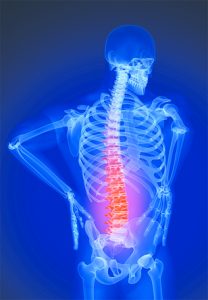 Degenerative Disc Disease (DDD) describes arthritis of the spine resulting in low back pain caused by a
Degenerative Disc Disease (DDD) describes arthritis of the spine resulting in low back pain caused by a
combination of inflammation of the damaged discs and a lack of spinal stability. In some patients, the pain may travel from the low back down into the hips and buttocks – a condition called sciatica. Unlike most other forms of osteoarthritis, DDD is common even in young adults, most often due to a sudden strain or impact injury, but naturally people tend to become more susceptible to it as they get older.
“The good news is that the vast majority of DDD cases respond well to conservative, nonsurgical therapies and pain episodes can be avoided or significantly reduced with positive lifestyle changes,” says ONC board certified neurosurgeon Antonio DiSclafani, MD.
ONC has successfully treated numerous DDD patients using safe, nonsurgical methods, such as physical therapy exercises, including a routine of stretches aimed at improving the flexibility and motion of the spine and low back muscles and ligaments, hamstrings (rear thigh muscles), and psoas major muscles of the hips, as well as low back and abdominal strengthening exercises to bolster spine and posture support. “I often partner with local physical therapists who can provide one-on-one training customized for each patient and his or her condition,” says Dr. DiSclafani. “That way patients can take their time and really get a feel for what they should do at home to manage and prevent pain episodes.”
For immediate relief, some patients may use OTC pain relievers like acetaminophen (Tylenol) or NSAIDS (aspirin, ibuprofen, naproxen.) In some cases Dr. DiSclafani may use a prescription-strength anti-inflammatory medication, a narcotic pain reliever, an oral steroid or a muscle relaxer, depending on the patient’s pain level, medical history and present circumstances. If pain doesn’t respond to medication, some patients get lasting relief from epidural steroid injections, which can be performed up to three times a year. “Patients who respond to injections often Just as important to pain management therapy is adopting a healthier lifestyle, which, for many, takes quite a bit of adjustment. “The lifestyle changes I recommend can be difficult for some patients,” notes Dr. DiSclafani, “but the benefits extend beyond just managing low back pain to promoting better health and well-being overall, so their importance cannot be overstated.”
The healthy habits Dr. DiSclafani recommends include:
Achieving and maintaining a healthy weight – excess weight can place undue stress on muscles and ligaments. Losing even ten pounds can reduce the burden on the low back.
Staying or becoming active – combining low-impact aerobic exercises like walking, stationary biking and water aerobics with strengthening and stretching techniques promotes healing and helps prevent pain flare-ups.
Good posture – slumping, slouching and improper lifting can irritate discs and their related nerves and muscles. Proper standing and sitting postures relieve disc pressure, and make you look and feel better, too.
Quitting tobacco – tobacco use, whether smoking, vaping or chewing, limits circulation, slows healing and weakens bones. The link between regular tobacco use, delayed healing and chronic pain is so well documented that some insurance companies won’t cover certain spinal treatments unless a patient quits using it.
In the uncommon cases where a patient’s severe or unremitting pain doesn’t respond to conservative treatments, Dr. DiSclafani may discuss surgical options. “Happily, most patients with DDD never need to go that route,” he says.
“With time, commitment and some healthier habits, most people experience significant relief from pain, improved function and a renewed enjoyment of life, proving conservative treatments really work.”
If chronic low back pain is slowing you down, don’t wait – call ONC today and get started on safe, effective treatment designed to make degenerative disc pain a thing of the past.
ANTONIO DiSCLAFANI, MD
• In practice of neurosurgery since 1988. Joined Ocala Neurosurgery Center in 1993
• Board Certified in Neurological Surgery by the American Board of Neurological Surgery
• Medical Degree from the University of Texas Health Science Center in Houston
• Residencies at the University of Tennessee & St. Jude Hospital in Memphis
• Member, Alpha Omega Alpha Honor Medical Society
• Fellow, American College of Surgeons
• Fellowships in neuro-oncology, University of California at San Francisco & St. Jude Hospital in Memphis
• Certified by the National Board of Medical Examiners
• On staff at Munroe Regional Medical Center & Ocala Regional Medical Center
Dr. Antonio DiSclafani, his partner neurosurgeons, Dr. Mark Oliver and Dr. Daniel Robertson, and their talented support team are dedicated to providing unsurpassed diagnostic and therapeutic care for a range of neurological and spinal disorders. Our foremost mission is to help you return to a life of health, comfort and vitality.
Ocala Neurosurgical Center
OcalaNeurosurgicalCenter.com
352-622-3360
Check Also
CHOOSING THE RIGHT SUNGLASSES: UV PROTECTION AND STYLE COMBINED
When it comes to selecting the perfect pair of sunglasses, it’s imperative to have both …
 Central Florida Health and Wellness Magazine Health and Wellness Articles of the Villages
Central Florida Health and Wellness Magazine Health and Wellness Articles of the Villages



